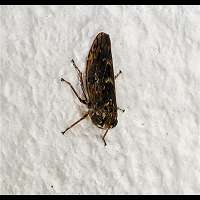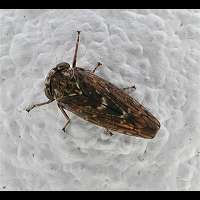Idiocerus heydenii
Within the genus Idiocerus there are some 20 species in the Netherlands. The genus is usually split up into three groups, depending on the plant they live on. There is a Willow group, an Alder group and a Maple group. Our Idiocerus heydenii belongs to the Maple Group (often referred to as genus or sub genus Acericerus). This presents us with a problem, for it has a few cousins that are extremely similar. And to make matters even more complicated there always is the possibility of import from the Far East. Besides, scientists are still not absolutely sure how many species there actually are. The whole group has not been studied intensively yet. Se we can't promise this is Idiocerus heydenii, it may be one of its close relatives instead! Because of the simple style of the antennae, just a straight forward hair like object, we can definitively say this is a female. It is a very well marked female, though. This may be due to the fact the picture was taken in March, meaning the animal is just after hibernation. Many Heteroptera and Homoptera get darker just before or during overwintering. The Leafhopper expert I consulted reports that the adults prefer the end of thin twigs to live on. The females lay their eggs in twigs. They have a little saw, used for making an opening in a twig. Then the egg is deposited inside. Little else is known about these creatures. Idiocerus heydenii is rare in Holland and Germany and we do not know anything about it presence elsewhere. This could even be a non-British species. Anyway, even if it is a British species, it most possibly will hardly ever been seen in a common garden.
Within the genus Idiocerus there are some 20 species in the Netherlands. The genus is usually split up into three groups, depending on the plant they live on. There is a Willow group, an Alder group and a Maple group. Our Idiocerus heydenii belongs to the Maple Group (often referred to as genus or sub genus Acericerus). This presents us with a problem, for it has a few cousins that are extremely similar. And to make matters even more complicated there always is the possibility of import from the Far East. Besides, scientists are still not absolutely sure how many species there actually are. The whole group has not been studied intensively yet. Se we can't promise this is Idiocerus heydenii, it may be one of its close relatives instead! Because of the simple style of the antennae, just a straight forward hair like object, we can definitively say this is a female. It is a very well marked female, though. This may be due to the fact the picture was taken in March, meaning the animal is just after hibernation. Many Heteroptera and Homoptera get darker just before or during overwintering. The Leafhopper expert I consulted reports that the adults prefer the end of thin twigs to live on. The females lay their eggs in twigs. They have a little saw, used for making an opening in a twig. Then the egg is deposited inside. Little else is known about these creatures. Idiocerus heydenii is rare in Holland and Germany and we do not know anything about it presence elsewhere. This could even be a non-British species. Anyway, even if it is a British species, it most possibly will hardly ever been seen in a common garden.





